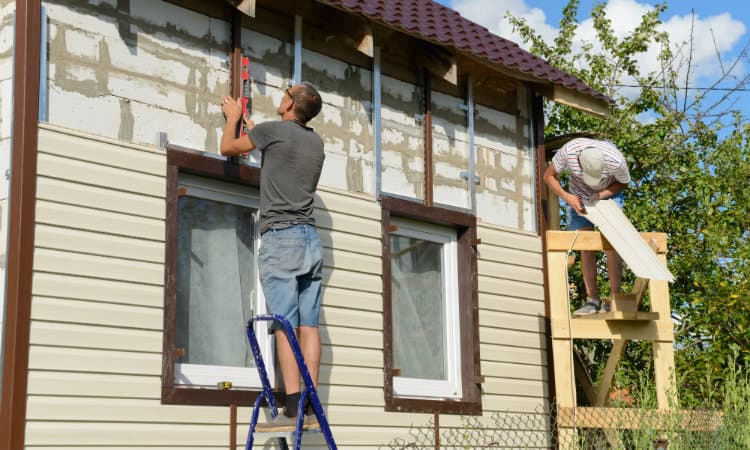Labor to install vinyl siding sets the stage for this comprehensive guide, offering readers a detailed look into the process with a mix of casual and formal language styles. From materials needed to the installation process, this guide covers it all.
As we delve deeper into the topic, you'll uncover the essential steps and considerations required for a successful vinyl siding installation project.
1
Vinyl siding snips are specialized cutting tools designed to make precise cuts on vinyl siding panels. These snips have sharp blades that can easily cut through the material without causing any damage. When using vinyl siding snips, always wear gloves to protect your hands from sharp edges.
Materials Needed
To properly install vinyl siding, you will need the following materials:Vinyl Siding Panels
Vinyl siding panels are the main component of the installation process. They provide the exterior covering for your home and come in a variety of colors and styles.J-Channel
J-channel is used to trim around windows, doors, and corners. It helps provide a clean, finished look to the siding installation.Soffit and Fascia
Soffit and fascia are essential for ventilation and protecting the eaves of your home. They also add a decorative touch to the overall appearance of the siding.Nails and Screws
Nails and screws are used to secure the siding panels and trim pieces to the exterior of your home. It is important to use the proper fasteners to ensure the siding stays in place.Trim Pieces
Trim pieces, such as inside and outside corners, starter strips, and utility trim, help to create a seamless look and protect the edges of the siding panels.House Wrap
House wrap is a moisture barrier that helps protect your home from water damage. It is installed underneath the siding to provide an extra layer of protection.Level, Tape Measure, and Utility Knife
Tools such as a level, tape measure, and utility knife are essential for accurately measuring and cutting the siding panels to fit your home's dimensions.Quality Considerations
When selecting materials for vinyl siding installation, it is important to consider the quality of the products. Look for durable, weather-resistant materials that are designed to withstand the elements. Investing in high-quality materials will ensure that your siding lasts for years to come without needing frequent repairs or replacements.Preparation Steps
Before starting the installation of vinyl siding, it is crucial to properly prepare the exterior wall surface. This ensures a smooth and successful installation process, as well as the longevity of the siding. Here is a detailed guide on how to prepare for vinyl siding installation:Exterior Wall Surface Preparation
- Clean the exterior wall surface thoroughly to remove any dirt, debris, or mold. This can be done using a pressure washer or a mixture of water and mild soap.
- Inspect the wall for any damage, such as rot or water infiltration. Make necessary repairs to ensure a solid and stable surface for the siding to be installed on.
- If there are any existing layers of siding, remove them carefully to expose the original wall surface. This will allow for a proper installation of the new vinyl siding.
- Apply a house wrap or moisture barrier to the exterior wall surface. This will help prevent moisture from seeping behind the siding and causing damage.
Special Considerations
- Ensure that the exterior wall surface is completely dry before installing the vinyl siding. Moisture trapped beneath the siding can lead to mold growth and structural issues.
- Take note of any electrical outlets, fixtures, or other obstacles on the wall surface. Make necessary adjustments to accommodate these features during the installation process.
- Consider the climate and weather conditions in your area. Extreme temperatures or high winds can affect the installation process, so plan accordingly.
Installation Process
Installing vinyl siding involves several steps to ensure a proper and secure installation. From cutting and fitting the siding panels to handling corners, windows, doors, and other obstacles, here is a detailed guide on how to install vinyl siding effectively.Cutting and Fitting Siding Panels
- Measure the length of the wall and cut the siding panels accordingly using tin snips or a circular saw with a fine-tooth blade.
- Make sure to leave a small gap at the end of each panel to allow for expansion and contraction due to temperature changes.
- Fit the panels onto the wall, ensuring they are level and straight. Use a level to check for accuracy.
Securing the Siding Panels
- Start at the bottom of the wall and work your way up, overlapping each panel to prevent water infiltration.
- Nail the panels to the wall, making sure to place the nails in the center of the nailing slots to allow for movement.
- Avoid overdriving the nails, as this can cause the siding to buckle or warp.
Handling Corners, Windows, Doors, and Obstacles
- For corners, cut the siding panels at a 45-degree angle and overlap them to create a seamless corner.
- Around windows and doors, use J-channels to frame the openings and secure the siding in place.
- When encountering obstacles like pipes or vents, carefully cut and fit the siding around them to maintain the integrity of the installation.
Tools and Equipment
When installing vinyl siding, it is essential to have the right tools and equipment to ensure a smooth and successful installation process. Each tool serves a specific purpose and contributes to the overall quality of the finished project.1
. Vinyl Siding Snips
Vinyl siding snips are specialized cutting tools designed to make precise cuts on vinyl siding panels. These snips have sharp blades that can easily cut through the material without causing any damage. When using vinyl siding snips, always wear gloves to protect your hands from sharp edges.
2. Utility Knife
A utility knife is a versatile tool that can be used for various tasks during vinyl siding installation, such as scoring, trimming, and cutting. It is essential to have a sharp utility knife to ensure clean and accurate cuts on the siding panels. Always use caution when handling a utility knife to prevent accidents.3. Tape Measure
Accurate measurements are crucial when installing vinyl siding to ensure a precise fit and a professional finish. A tape measure is a basic tool that helps you measure the length of siding panels, corner posts, and other components accurately. Double-check all measurements before making any cuts to avoid costly mistakes.4. Level
A level is essential for ensuring that the vinyl siding panels are installed straight and level on the wall. Using a level helps you maintain a uniform appearance and avoid any unsightly gaps or uneven lines. Make sure to check the level frequently as you install the siding to maintain a professional finish.5. Siding Removal Tool
A siding removal tool is used to remove existing siding from the wall before installing new vinyl siding. This tool helps you pry off old siding panels without damaging the underlying structure. Be gentle when using a siding removal tool to prevent any unnecessary damage to the wall.6. Ladder
A sturdy ladder is essential for working safely at heights during vinyl siding installation. Choose a ladder that is the right height for the job and ensure that it is stable and secure before climbing. Always follow proper ladder safety practices to prevent accidents and injuries.Remember to wear appropriate safety gear, such as gloves, safety glasses, and work boots, while using tools and equipment during the vinyl siding installation process. Safety should always be a top priority to ensure a successful and accident-free project.Cost and Labor Considerations
Installing vinyl siding involves various cost factors related to labor, materials, and the complexity of the project. Understanding these considerations is crucial for budgeting and planning purposes.Breakdown of Labor Costs
- Labor costs typically make up a significant portion of the total expenses for installing vinyl siding.
- Factors influencing labor costs include the size of the project, the experience of the installation crew, and the location of the property.
- Additional costs may arise if any structural repairs or modifications are needed before the siding installation.
Impact of Project Complexity on Labor Costs
- The complexity of the project, such as the architectural design of the house, the presence of obstacles like trees or uneven terrain, and the need for custom cuts or special configurations, can significantly affect labor costs.
- A more complex project may require more time and effort from the installation crew, leading to higher labor expenses.
- Proper planning and communication with the installation team can help minimize unexpected costs associated with project complexity.
Average Time for Installation
- On average, a professional installation crew can complete the installation of vinyl siding on a typical home within a few days to a week.
- The exact duration depends on factors such as the size of the property, the level of detail required, and the weather conditions during the installation process.
- Efficient coordination and teamwork among the crew members can help expedite the installation process without compromising quality.









